Those who have been paying close attention might note some tantalizing parallels in the politics of the United States and the United Kingdom.
In 2016, the passage of the Brexit referendum in the U.K. and the election of Donald Trump in the U.S. both involved appeals to nationalism and right-wing populism and promised greater restrictions on immigration.
While both political movements were supported most strongly by older and less well educated voters, they also helped generate a counter-reaction of activism and participation in 2017 among the mostly younger voters, who saw their preferred choice lose the year before.
In the weeks leading up to the 2017 U.K. general parliamentary election, SurveyMonkey’s tracking polling revealed the enormous differences in voter preferences by age.
In our post-election survey, Labour ran ahead of the Conservatives by a better than three-to-one margin (61 to 20 percent) among voters between the ages of 18 and 24, while voters over 65 preferred the Conservatives by a nearly identical margin (62 to 20 percent).
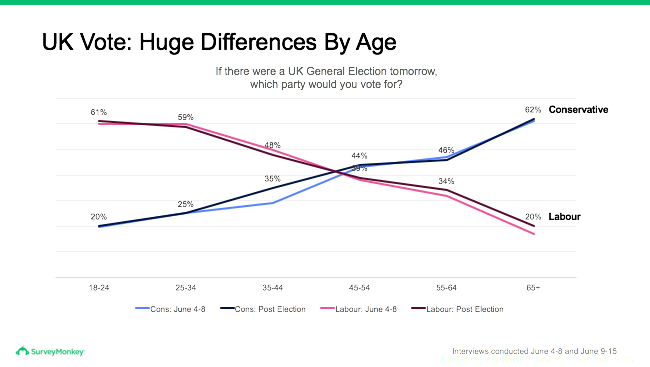
The 2017 general parliamentary election in the U.K. produced a surprise, with the Labour Party scoring major gains and Conservative Party losing its outright majority resulting in a “hung parliament” (The Conservatives will remain in power after reaching a partnership deal with Northern Ireland’s Democratic Unionist Party). To get a better sense for what these results might portend for U.S. politics, we turn to over 100,000 interviews we conducted before and just after the U.K. 2017 election. We have confidence in our results, especially among relatively small subgroup of the population, because of the scale of interviews possible with our platform. That scale allows for far more complex weighting and likely voter modeling than is possible with smaller sample sizes.
Of course, much of the 2017 U.K. race had little parallel to U.S. politics. Our tracking helps demonstrate how Prime Minister Theresa May’s missteps as a campaigner and negative reactions to the Conservative Party’s platform helped erode her early polling lead during the course of the campaign
Our polling showed a decline in satisfaction with May’s performance as Prime Minister during the final three weeks of the campaign, from 55 to 45 percent, while satisfaction with Labour Party Leader Jeremy Corbyn rose steadily from 34 to 41 percent satisfied.
These trends paralleled a narrowing of voter preferences from a 15-point Tory lead (48 to 33 percent) with three weeks remaining, to only four points on the eve of the election, with the most dramatic declines coming just after release of the Conservative Party platform on May 18.
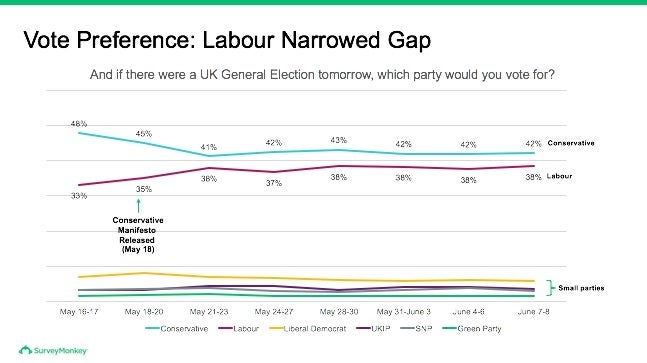
The election result was a loss of 13 seats for the Conservatives, falling to 313, just below the 326 necessary to form a majority government; the Labour Party gained 30 seats. The Conservatives received 42.4 percent of the vote, a near match to the 42 percent forecast by our tracking poll in the final week of the campaign. Labour received 40 percent of the vote, just two points higher than our final forecast of 38 percent. The unmatched accuracy of our final estimate came, in part, because of our unique ability to reach millennials, less engaged voters who don’t use the phone to talk, meaning traditional telephone pollsters may have trouble capturing their voices.
Common Trends?
While much of what created trouble for the Conservative Party in 2017 was specific to the U.K, we do see intriguing parallels in counter-reactions to Brexit in the U.K. and Trump in the U.S.
Our 2017 post-election survey in the U.K. shows how the Brexit referendum helped reshape British politics. Those who voted Conservative in 2017 were more likely to report voting to leave the EU (67 to 26 percent) than those who say they voted Conservative in 2015 (60 to 35 percent). Put another way, the voters the Tories picked up since 2015 were overwhelmingly in the Leave camp (72 percent).
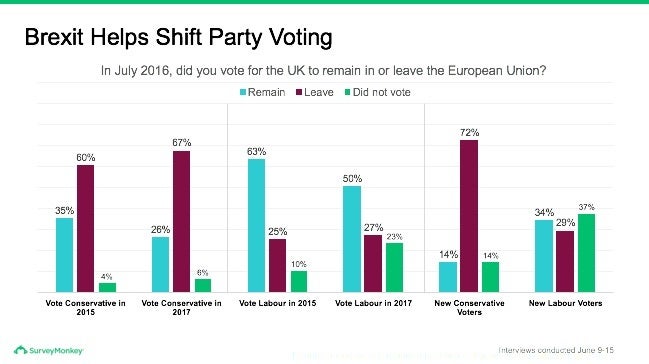
For the Labour party, the connection to the Brexit vote is more complex since it is linked to younger voters. More than a third (37 percent) of Labour’s new voters did not vote in the 2016 Brexit referendum, and these new voters were overwhelmingly young.
Which brings us back to the stark differences by age. The trends are similar but even more politically polarized by age group than in the U.S. Consider how the Conservative’s vote by age tracks with what our 2016 post-election survey in the U.S.. The results are nearly in parallel, with slightly bigger gaps in the U.K. among the youngest and oldest voters.
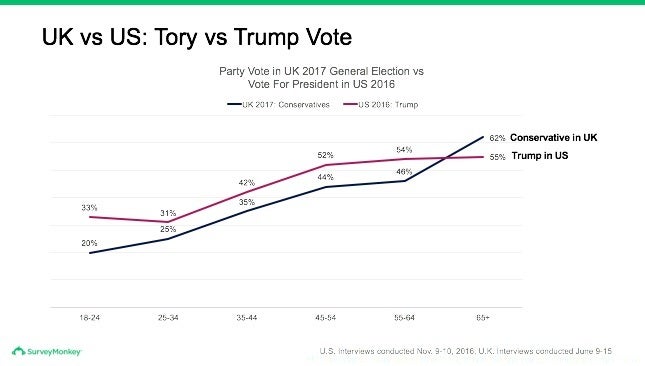
Compare the tabulation of May’s job satisfaction rating by age among U.K. voters just before the election to Donald Trump’s job rating tabulated by age over the past week (moments when their aggregate ratings were near matches, 45 percent satisfied with May overall compared to 43 percent satisfied with Trump). May’s rating is slightly lower among the youngest voters in the U.K. than Trump’s in the US, and slightly higher among the oldest voters in the two respective countries.
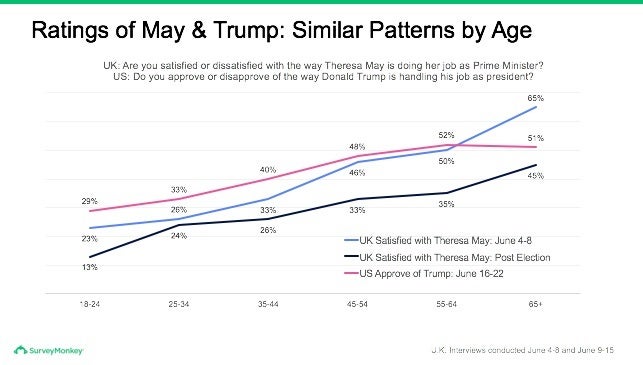
Labour’s massive support among younger voters also meant they depended far more than the Conservatives on infrequent voters. Younger voters are typically less likely to vote, plus some of the U.K.’s youngest voters were not eligible to cast a ballot in the two most recent elections in 2015 and 2016.
Thus, according to our post-election survey, the Conservatives carried those who voted in the two most recent elections by a wide margin (50 to 34 percent), while the Labour Party dominated among those who missed one or both, winning those who voted in no previous election by a whopping 73 to 16 percent margin.

The enthusiasm for Labour also translated into greater apparent turnout among younger voters than in recent U.K. elections. Our post-election survey was not designed to measure voter turnout among all adults, but the patterns in self-reported turnout by age support the notion of an increase in turnout among the youngest age cohorts compared to recent elections in the U.K.
Something similar has been evident in the handful of special elections held recently in the U.S. The Democrats have outperformed their partisan baseline vote in all five special Congressional elections this year by an average of eight percentage points, according to David Wasserman of the the Cook Political Report.
The recently concluded race in Georgia’s 6th District “produced probably the strongest Democratic turnout in an off-year election in at least a decade,” according to Nate Cohn of the New York Times, a turnout that included “a surprising number of irregular young and nonwhite voters.”
These results also come with an obvious caveat. Despite the gains, the Labour Party ran behind the Conservatives in the U.K., and the Democrats have been defeated in all five of the special congressional elections held thus far (though all were in strongly Republican districts).
Democrats will likely gain in the 2018 mid-term elections – such elections typically produce a backlash against the President’s party – but we are a long way off from knowing how big those gains might be.
Methodology: This analysis is based on surveys of voters in the United Kingdom conducted online between May 16 through June 8, 2017 among national samples of 193,784 adults ages 18 and up adjusted to represent those likely to vote in a Parliamentary election, and another 11,791 adults interviewed June 9 through June 15 who say they voted in the June 8 election. All respondents were selected from the nearly 3 million people who take surveys on the SurveyMonkey platform each day. Data were weighted for age, sex, education, country of birth, marital status, region, and past vote, using the UK Census 2011 demographic tables and British Election Study (BES) 2015 Face-To-Face sample to reflect the demographic composition of the United Kingdom. In addition, pre-election interviews were adjusted to represent likely voters using a model constructed from validated voters of BES 2015 is used to calculate individual voting propensities. The post election survey was weighted to match election results by region. This article is cross-posted to the SurveyMonkey blog.
